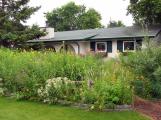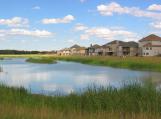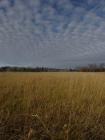1
Start of 15: Current Efforts in Prairie Preservation: Paul Mutch3
My masters project is looking at urban Tall Grass Prairie which is kinda a weird concept to some people but I guess over the past, say, 20 years there's been a lot of projects trying to restore prairies in a lot of rural, sorry, how about-urban areas. The city did a whole bunch, starting I guess in the 80s and really since that time, no one's ever gone back to look at all these projects and they've kinda been done and left and no one's assessed how well they're doing and what kind of habitat they're providing and that kinda thing. So my project is basically going back to all these restorations that have been done over the years and looking at them and comparing them and seeing what's working and what isn't working and just trying to figure out how much, well, basically what these urban restorations are providing in terms of prairie and then as well, kind of a spin off project, is looking at how these restorations are affecting kind of social structure or how people value these prairies. Roundabout explanation of the project.5
...increased interest in prairie gardening in the past decade or so?I would say definitely. Just even from the increase in industry supplying seed and plants just to what you can see driving around the city. You can see that people are interested, they're planting more natural gardens as opposed to your more traditional English Garden, where its plants with bare dirt around them. You can see people kind of making it look more natural with a diversity of species and it's not as orderly and that kind of thing.
7
The kinda of urban prairie restoration or prairie garden whatever you'd like to call it is smaller than a prairie. And there's limiting factors as well, the management of it is quite a bit different, like you can't burn your yard, at least not easily so it's different to maintain. And generally they're more multi-use too. People do them for a lot of different reasons; they do them for educational reasons to kinda inform people about what the prairie is; they do them for aesthetic reasons, as an aesthetic centre point or for personal reasons, like they just really love the prairie and want to be connected to it. Or they like the garden and are interested in kinda natural systems. So those are some of the bigger things I can think of.9
Less than one percent of the remaining prairie in Manitoba is left today. So obviously the prairie's in a pretty dire straight. Thinking about it, kind of, it seems like the restoration and conservation have to both happen together. Like the conservation of remaining prairies isn't enough at this point, cause there's so little left. So I think that the urban restoration's important both for providing prairie habitat and protecting species and that kind of thing, but maybe more important is the educational role it plays in making people who haven't seen prairie outside of the city to see what it can be like in the city and to then to get people more interested in visiting Tolstoi or even Living Prairie Museum which is a larger example of prairie in the city.11
I find my impressions have definitely changed as I learned more. I would say originally looking at a place like the Living Prairie Museum or the Rotary Prairie, it's pretty easy to imagine that it's just a place that no one's done anything with. Just a whole bunch of grass and a few flowers, and it doesn't really look that impressive until you know what's there and I guess my impression's changed as I've become more aware of the years that have taken to establish that and how if it's removed, it might take a hundred years to reestablish that community of plants and the insect diversity, so in a sense I know that my impression of the prairie has changed, whether I can define what it is I'm not sure.13
I think this surge in prairie garden is a positive change and maybe the first positive change for prairie in quite a while.Great. And what do you think of the future viability of the prairie ecosystem?
I think it needs continual help, I think it needs people who are aware of what's happening and what's happened and what the prairie really is as opposed to my preconceived notions of like ‘there's prairie everywhere, farm is a prairie, if you have grasses growing, it's a prairie.' So people need to be aware of what a prairie really is and I think it's gone beyond the place of the point where we can just conserve what's left, we need to actively restore areas to prairie if we hope to maintain it, if we hope it be around in another thirty years.





